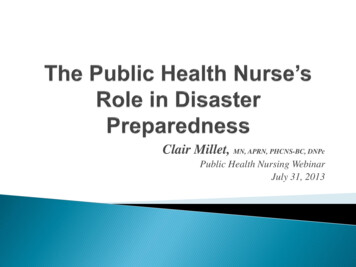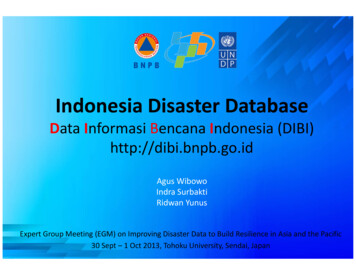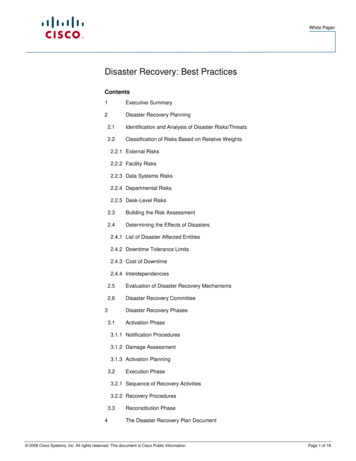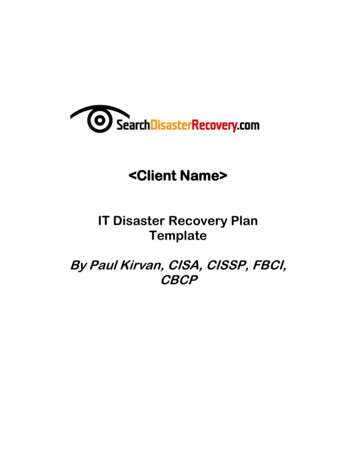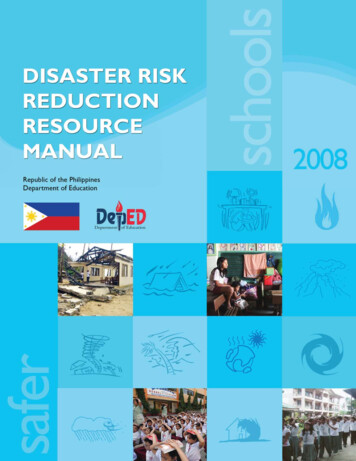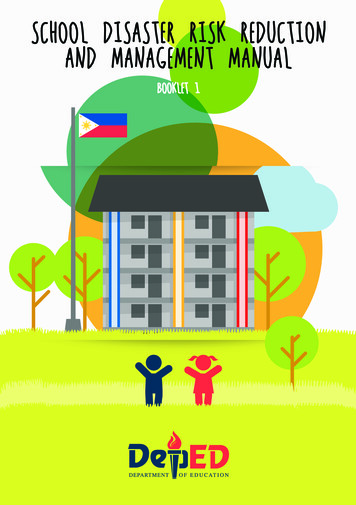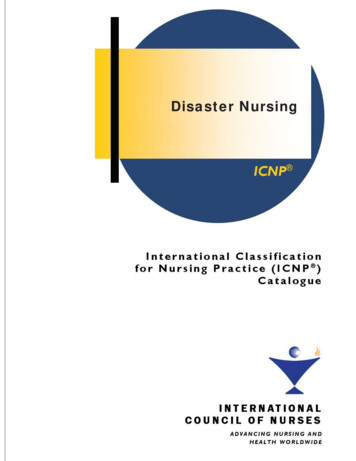
Transcription
Disaster Nursing
Disaster NursingA shared project withthe ICN Centre for Disaster NursingResearch, Flinders University SAInternational Classificationfor Nursing Practice (ICNP )Catalogue
All rights, including translation into other languages, reserved. No part ofthis publication may be reproduced in print, by photostatic means or in anyother manner, or stored in a retrieval system, or transmitted in any form, orsold without the express written permission of the International Council ofNurses. Short excerpts (under 300 words) may be reproduced withoutauthorization, on condition that the source is indicated.Copyright 2017 by ICN – International Council of Nurses,3, place Jean-Marteau, 1201 Geneva, Switzerland2
TABLE OF CONTENTSAcknowledgements2Contributors2ICNP Catalogues3Purpose3Significance to Nursing3Figure 1: The intersection of disaster phases and nursingDisaster Nursing ICNP Statements45Table 1: Diagnoses and outcomes for disaster nursing7Table 2: Interventions for disaster nursing15Bibliography21Additional Reading221
Title: Disaster NursingCatalogue Type: Terminology SubsetPublication Date: 2015, Updated 2017ACKNOWLEDGEMENTSThe International Council of Nurses (ICN) is pleased to acknowledge the hundreds of nursesand other experts worldwide who contribute to the ongoing development and disseminationICNP . This ICNP Catalogue was developed in collaboration with the ICN Centre forDisaster Nursing Research, Flinders University SA.CONTRIBUTORS to this ICNP CataloguePaul Arbon, PhD, RN, Dean and Professor, School of Nursing and Midwifery, FlindersUniversity SA.Genevieve Brideson, PhD Candidate, BNg (Hons), Grad Cert Aviation, RN, RM, School ofNursing and Midwifery, Flinders University SAAmy Coenen, PhD, RN, FAAN, Professor at the University of Wisconsin-Milwaukee Collegeof Nursing, Milwaukee, Wisconsin, USAKristine Gebbie, BSN; RN; MN; DrPH, Adjunct Professor, School of Nursing and Midwifery,Flinders University SAKaren Hammad, PhD Candidate, BN (Hons), GradDipEmergNsg, RN, School of Nursing andMidwifery, Flinders University SAKay Jansen, DNP, RN, Clinical Associate Professor at the University of Wisconsin-MilwaukeeCollege of Nursing, Milwaukee, Wisconsin, USALidia Mayner, , Associate Prof, BSc, BSc (Hons), BN, PhD, RN, Director Flinders UniversityResearch Program for Disaster Nursing, ICNP,, School of Nursing and Midwifery, FlindersUniversity SALesley Siegloff, Associate Dean (Practice Development), PhD Candidate, DipT (NEd)SturtCAE, BEd (Nursing) SACAE, MNA (UNSW), FACN, RNNote: Creation of this catalogue was a group endeavour. Author order does not indicateamount of contribution.2
ICNP CATALOGUESThe International Classification for Nursing Practice (ICNP ) is a unified nursing languagesystem that supports the standardisation of nursing documentation at the point of care. Theresulting data-based information can be used for planning and managing nursing care,financial forecasting, analysis of patient outcomes and policy development. The ICNPStrategic Advisory Group and many other expert nurses involved with ICNP have recognisedthat manageable subsets of the terminology should be available to nurses working withpatients or clients in selected specialties and settings.Catalogues are subsets of ICNP that allow nurses to more readily integrate ICNP into theirpractice as they work in a specialty area or with clients having specific health conditions orneeds.Catalogues do not replace the clinical judgement of the nurse. Nurses can use Catalogues asreference tools for documenting care and reflecting on their practice. Nurses’ clinicaljudgement and decision-making are essential for individualised care of patients and theirfamilies and cannot be replaced by any tool.PURPOSESThe purposes of this catalogue are to facilitate: Documentation of nursing practice by nurses working in disaster situationsConsistent and meaningful communication within the discipline of nursing and acrossother professions;Articulation of disaster nursing practice;Description, comparison and reuse of data by disaster nurses across the globe;Retrieval of comparable nursing data to evaluate quality of care and to direct policy.The clients for disaster nursing include patients, families and groups experiencing a disasterin the community. This ICNP catalogue focuses specifically on the provision of disasternursing services worldwide.SIGNIFICANCE TO NURSINGThe ICNP Catalogue for disaster nursing is significant to nursing for several reasons: 1)reflects nursing leadership and research in disaster nursing; 2) shows how the nursingprocess guides nursing care; and, 3) demonstrates the commitment of nursing to high qualityhealth care. This section of the catalogue will briefly discuss these main points.Nursing leadership and research in disaster nursingNursing has been a part of the response to a wide range of natural disasters (e.g., floods,cyclones, earthquakes, extremes of heat and cold) and disasters related to human activity(e.g., industrial explosions, airplane crashes, war, terrorism) for many years. The multipletypes of patients the disaster nurse may care for and the environment in which the patient istreated dictates that the disaster nurse is prepared for a variety of challenges. The role of thedisaster nurse is multifaceted and includes practice, education, management, consultation,advocacy and research. Disaster nurses come from a variety of specialty nursing areas and3
all bring a wealth of expertise of different types and levels to the people experiencing adisaster.Interest in clarifying the roles carried out by disaster nurses, and the competencies they needto fulfil these roles, has intensified since the late 1990’s and continues today. Some attentionhas been paid to disaster and emergency skills needed by all nurses (World HealthOrganization & International Council of Nurses, 2009) while others have considered onlyindividual specialty nurses such as those in the areas of public health practice, emergencydepartments, intensive care units, flight nurses and nurses involved in military service. Giventhe extensive range and specialisation of nurses from around the globe who are involved inthe complexity of the entire spectrum of disaster health from pre-event planning throughrecovery, it is not surprising that there are multiple perspectives on what nurses need toknow, and how they will apply that knowledge. Figure 1 illustrates the intersection of issuesfor nursing and disasters.Figure 1. The intersection of disaster phases and nursing. (Adapted from Walsh et al., ediateresponseLong termresponseRecoveryPreparingindividualdisaster planwith patientParticipate inworkplaceplanningParticipate incommunityactivities tominimize disasterimpactsProvideimmediate care ifon the disastersiteProvideongoingcare todisastervictimsadmitted toplace ofpracticeProvide ongoingcare to anyonewith extendedpost-disasterconcerns/problemsNurses inemergency/trauma carePreparingwork site toreceive injuredPrepare for/provide care tothose brought tohospitalNurses ondisasterresponseteamsParticipate inexercises/preparation formobilisationParticipate incommunityactivities tominimize disasterimpactsParticipate incommunityactivities tominimize disasterimpactsNurses inpolicypositionsAssurenursingperspectivesare included inplanningParticipate incommunityactivities tominimize disasterimpactsPrepareorganisation toreceive victimsNursingGroupAnypracticingnurseProvide care forassignedpopulation whenmobilised todisaster site4Share lessonslearned withplanners forimprovementProvideongoingcare todisastervictims ifmobilisationcontinuesAssure thatneededcontinuedcare isprovided tovictimsShare lessonslearned withplanners forimprovementTake steps toassist in returningorganisation topre-disaster state.Evaluate allnursing responseactivities andinclude inimprovedplanning
Nursing process guides nursing careRegardless of the precise manner in which an individual nurse becomes involved in practicerelated to disasters and major emergencies, it is useful for them to use consistent languageto communicate with one another about the assessments and diagnoses they make, theinterventions they carry out, and the outcomes of their patients. This catalogue identifies theICNP concepts – nursing diagnoses, outcomes and interventions that are most likely to behelpful in disaster nursing. Capturing data through the use of a standardized terminologysuch as that found in this Catalogue also can be useful to nurse researchers as they seek toevaluate nursing practice and patient and family outcomes, through the use of a standardisedclinical data set and thus make the processes and outcomes of disaster nursing care morevisible.Commitment of nursing to high quality health careGiven that the ICNP terminology is intended primarily for use at the point of care, theconcepts included in this Catalogue are most likely to be of value during the immediate andlonger-term response phases by those nurses who are providing care to individuals andfamilies. However, nurses with disaster experiences and roles illustrated in figure 1 shouldmake every effort to use the terminology presented when it is possible, as a way ofcontinuing to strengthen communication across the global nursing profession.Establishing consistent evidence-based practice standards in nursing is important to guidepractice. Representing these practice standards using ICNP can facilitate the capture ofinformation about the effect of nursing on patient outcomes.DISASTER NURSING DIAGNOSTIC, OUTCOME AND INTERVENTIONSTATEMENTSThis Catalogue fills a practical need by listing ICNP statements for diagnoses, outcomesand interventions for disaster nursing. The list provided below aims to be comprehensive butit is understood that the list does not exhaust the domain. The statements are intended to beexamples only and are not intended to be prescriptions for practice. Catalogues cannotreplace the clinical judgement of the professional nurse.The statements were organised into a framework by the disaster nursing group involved withdevelopment of this catalogue. Physiological, psychological, social, and environmentalneeds of patients and families are addressed in this framework. The framework categoriesinclude: Cardiovascular, Caregiver/Care Process, Cognitive, Communication, Death andDying, Fluid Balance/Nutrition, Integument, Medication Management,Metabolic/Thermoregulatory, Musculoskeletal, Neurological, Pain, Psychological,Respiratory, Safety/Mitigation, Social/Environmental, and Trauma.Nursing diagnoses and nursing outcomes are listed alphabetically under each category. InICNP, nursing diagnoses may include either a positive assets or a problem condition of aclient. Nursing outcomes are the measure or status of a nursing diagnosis at points of timeafter a nursing intervention (ICN, 2008). In this catalogue, diagnosis and outcomestatements are listed under the heading Nursing Diagnoses and Outcomes. Thesestatements would be documented in the client’s health record according to how they are used5
in practice. For example, effective airway clearance may be identified as either a diagnosis oroutcome statement.Nursing interventions are also listed alphabetically under each category. The interventionsare not necessarily exclusive to one category. Likewise, the same diagnoses or outcomestatement could be represented in different categories.6
Table 1: Diagnoses and outcomes for disaster nursingConceptTypeNursingCategoriesCodeICNP Statement (2017 Release)Diagnoses and Caregiver / Care 3483810035507Altered Blood PressureBlood Pressure Within Normal LimitsBradycardiaEffective Cardiac FunctionEffective Cardiac OutputEffective Cardiovascular StatusEffective Physiological StatusImpaired Cardiac FunctionImpaired Cardiac OutputImpaired Cardiovascular SystemImpaired Physiological StatusNo Deep Vein ThrombosisRisk for BradycardiaRisk For Deep Vein ThrombosisRisk For Impaired Cardiac 510027787Able To Perform CaretakingCaregiver Able To Perform CaretakingConflicting Attitude Toward CareConflicting Attitude Toward TreatmentContinuity Of Care ProblemEffective Caregiver CopingEffective Continuity Of CareImpaired Ability Of Caregiver To PerformCaretakingImpaired Ability To Perform CaretakingLack Of Trust In Healthcare ProviderPositive Attitude To CareRisk For Caregiver 3633100005791002709810022091Acute ConfusionAdequate KnowledgeAlertCognition Within Normal LimitsConflicting Health BeliefConfusionDecisional ConflictDecreased ConfusionDeliriumCognitive7
ConceptTypeNursingCategoriesCodeICNP Statement (2017 Release)Diagnoses and 305010022070DisorientationDistorted Thinking ProcessEffective Decision MakingEffective Information ProcessingImpaired AlertnessImpaired CognitionImproved OrientationLack Of KnowledgeNo ConfusionReduced Decisional ConflictRisk For Acute ConfusionRisk For ConfusionRisk For 025104Able To CommunicateAble To Communicate VerballyCommunication BarrierImpaired CommunicationImpaired HearingImpaired Verbal CommunicationCommunicationDeath & Dying1004101710037834Fluid Balance / 110Death AnxietyFear About DeathAdequate HydrationAdherence To Fluid RegimeDehydrationEffective DefaecationEffective Gastrointestinal System FunctionImpaired Gastrointestinal System FunctionEffective Genitourinary StatusEffective Kidney FunctionEffective Urinary System FunctionFluid Balance Within Normal LimitsHypervolaemiaHypovolaemiaImpaired DefaecationImpaired Fluid IntakeImpaired Kidney FunctionImpaired Nutritional IntakeImpaired Urinary System FunctionKnowledge Of Fluid Regime8
ConceptTypeNursingCategoriesCodeICNP Statement (2017 784710025981Lack of Knowledge Of Fluid RegimeNauseaNo NauseaNo VomitingNutritional Intake Within Normal LimitsRisk For DehydrationRisk For HypervolaemiaRisk For HypovolaemiaRisk For Impaired Gastrointestinal System FunctionRisk For Impaired Nutritional IntakeRisk For 31531004423910001080100013441003378410000790Burn WoundEffective Peripheral Neurovascular FunctionEffective Tissue PerfusionImpaired Peripheral Neurovascular FunctionImpaired Peripheral Tissue PerfusionImpaired Tissue IntegrityIneffective Tissue PerfusionKnowledge Of Wound CareLatex AllergyDiagnoses and 10028555Medication sk For Impaired Peripheral NeurovascularFunctionRisk For Impaired Skin IntegrityRisk For Ineffective Tissue PerfusionRisk For Latex AllergyTissue IntegrityAble To Manage Medication RegimeAble To Procure MedicationAdherence To Medication RegimeAdverse Medication InteractionComplex Medication RegimeConflicting Attitude Toward MedicationManagementEffective Response To MedicationImpaired Ability To Manage Medication RegimeKnowledge Of MedicationKnowledge Of Medication RegimeLack Of Knowledge Of Medication9
ConceptTypeNursingCategoriesCodeICNP Statement (2017 Release)Diagnoses and 021682100430741004273710037604Metabolic / 810028071100276751003381110037322Lack Of Knowledge Of Medication RegimeMedication Side EffectMedication Supply DeficitNo Adverse Medication InteractionNo Medication Side EffectNon Adherence To Medication RegimeProblem With Medication ProcurementRisk For Adverse Medication InteractionRisk For Medication Side EffectAcid Base ImbalanceBlood Glucose Within Normal LimitsBody Temperature Within Normal LimitsEffective Acid Base BalanceEffective Electrolyte BalanceEffective ThermoregulationElectrolyte pothermiaImpaired ThermoregulationRisk For HyperthermiaRisk For HypothermiaRisk For Impaired ThermoregulationAble to MobiliseAble To TransferAble To WalkActive Range Of Motion Within Normal LimitImpaired Ability To TransferImpaired Active Range of MotionImpaired MobilityImpaired WalkingParalysisAgitationDecreased Intracranial Adaptive CapacityEffective Intracranial Adaptive CapacityEffective Nervous System FunctionEffective Neurological StatusImpaired Nervous System Function10
ConceptTypeNursingCategoriesCodeICNP Statement (2017 Release)Diagnoses and Outcomes10025395100278431003733310045668Increased Intracranial PressureReduced AgitationRisk For Impaired Nervous System 90610027917Coping With PainDifficulty Coping With PainDiscomfortInadequate Pain ControlKnowledge Of Pain ManagementLack of Knowledge Of Pain ManagementNo PainPainPain ControlPain Management SatisfactionPhantom PainReduced Pain10039877Risk For Negative Response To 7Able To AdjustAble to Participate In Care PlanningAcute Health CrisisAdherence To Therapeutic RegimeAnticipatory GriefAnxietyConflicting Cultural BeliefDecreased Depressed MoodDecreased PowerlessnessDecreased StressDenialDepressed MoodDifficulty CopingDisturbed Body ImageEffective CopingFatigueFearFear about AbandonmentFear About Being A Burden To OthersFear About ContagionGriefImpaired AdaptationPainPsychological11
ConceptTypeNursingCategoriesCodeICNP Statement (2017 Release)Diagnoses and 4410021742Impaired AdjustmentImpaired Psychological StatusNo DenialNo FatigueNon Adherence To Therapeutic RegimePositive Body ImagePositive Psychological StatusPowerlessnessReduced AnxietyReduced FatigueRisk For Depressed MoodRisk For Difficulty With CopingRisk For Dysfunctional GriefRisk For Impaired Psychological StatusRisk For PowerlessnessRisk For Situational Low Self EsteemSadnessSituational Low Self EsteemStress AspirationDyspnoeaEffective Airway ClearanceEffective BreathingEffective Gas ExchangeEffective Respiratory System FunctionFunctional DyspnoeaImpaired Airway ClearanceImpaired BreathingImpaired Gas ExchangeImpaired Respiratory System FunctionNo AspirationNo DyspnoeaRisk for ApnoeaRisk For AspirationRisk For Impaired Respiratory System Function10030144100302141002529710022384Adherence To Diagnostic TestAdherence To Safety PrecautionsContamination ExposureCrimeRespiratorySafety / Mitigation12
ConceptTypeNursingCategoriesCodeICNP Statement (2017 Release)Diagnoses and 1004219910042229100444681004229310035480Social / 6InfectionInflammationKnowledge Of Diagnostic TestLack Of Knowledge Of Diagnostic TestLack Of Response To TreatmentLack Of Symptom ControlNo Transfer injuryNo ViolenceNon Adherence To Diagnostic Testing RegimeNon Adherence To Safety RegimeProblem With High Complexity Of TreatmentRegimeRisk For Compromised DignityRisk For Contamination ExposureRisk For Cross InfectionRisk For DiseaseRisk For InfectionRisk For Transfer InjuryRisk For ViolenceRisk To Be Victim Of Child AbuseRisk To Be Victim Of Elder AbuseRisk To Be Victim Of Elder NeglectSymptom ControlTransfer InjuryTreatment ExhaustionVictim Of Child AbuseVictim Of Elder AbuseVictim Of Elder NeglectVictim Of Intimate Partner ViolenceViolent BehaviourAble To Manage FinancesAccess To TransportationEffective Environmental SafetyEffective SanitationEnvironmental Safety ProblemFinancial ProblemImpaired Ability To Manage FinancesInadequate Water SupplyLack Of Access To TransportationRisk for Environmental InjurySanitation Problem13
ConceptTypeNursingCategoriesCodeICNP Statement (2017 Release)Diagnoses and ed Response To Rape TraumaImproved Response To TraumaInjuryPost Trauma ResponseRisk For AnaphylaxisRisk For HaemorrhagingRisk For InjuryRisk For Post Trauma ResponseRisk For TraumaTraumatic Wound14
Table 2: Interventions for disaster nursingConceptTypeNursingCategoriesCodeICNP Statement (2017 113100162171004665310016168Caregiver / Care 1831003210910032258Assessing Arterial Blood Flow Using UltrasoundAssessing Cardiac StatusAssessing Cardiac Status Using Monitoring DeviceAssessing Risk For Ineffective Tissue PerfusionAssessing Tissue PerfusionBlood TherapyCardiopulmonary ResusciationChest CompressionsCompression TherapyIdentifying Risk For HaemorrhagingInserting Vascular Access DeviceInvasive Device Site CareManaging Central LineManaging Vasopneumatic DeviceMeasuring Blood PressureMeasuring Heart RateMonitoring Blood PressureMonitoring Cardiac StatusMonitoring Pedal PulseMonitoring Tissue PerfusionMonitoring Vital SignsPutting On Or In Haemostatic AgentReporting Presence Of Implantable Cardiac DeviceVenipunctureAdmission AssessmentAssessing Ability To Perform CaretakingAssessing Caregiver StressAssessing Physiological StatusAssisting Health Care ProviderCare PlanningCollaborating With PhysicianEvaluating Care PlanEvaluating Satisfaction With Health CareEvaluating Treatment RegimeIdentifying Physiological StatusMonitoring Physiological StatusMonitoring Response To TreatmentPhysical Examination15
ConceptTypeNursingCategoriesCodeICNP Statement (2017 05110026399100245041001682510041784Positioning PatientProtecting Patient Record And BelongingProtecting Patient RightProviding Emotional SupportProviding PrivacyProviding Privacy For Spiritual BehaviourReporting Status To Family MemberUse Aseptic 0025883100406891004069110021844Assessing AllodyniaAssessing Attitude Toward DiseaseAssessing Attitude Toward Health StatusAssessing Attitude Toward Treatment RegimeAssessing CapabilitiesAssessing CognitionAssessing Decision MakingAssessing Decisional ConflictAssessing Self 83Assessing Ability To Communicate By TalkingChecking Patient IdentityDebriefing Patient After RestraintEstablishing TrustExplaining Patient RightIdentifying Obstruction To CommunicationCognitiveCommunicationDeath & Dying1003801410026093100397051003749010041254Fluid Balance / 003933010036577100365831004209610039245Assessing Death TraditionAssessing Fear About DeathImplementing Comfort CarePost Mortem CareSupporting Dignified DyingAssessing Fluid BalanceAssessing Risk For DehydrationCollaborating In Fluid TherapyElectrolyte TherapyEvaluating Response To Fluid TherapyFluid TherapyMaintaining Intravenous AccessMaintaining Intravenous TherapyManaging Fluid TherapyMeasuring Fluid Intake16
ConceptTypeNursingCategoriesCodeICNP Statement (2017 31910043813Measuring Fluid OutputMonitoring Fluid BalanceMonitoring Fluid IntakeMonitoring Fluid OutputTeaching About Fluid 4112610032757100328711003320810033347Medication Management10030383100372481003041710025444Applying Cold PackApplying Compression BandageApplying Elastic StockingsApplying Hot PackAssessing Risk For Pressure UlcerAssessing WoundCategorising Surgical WoundMaintaining Skin IntegrityManaging OedemaPressure Ulcer PreventionSkin AssessmentSkin CareSuturing WoundTraumatic Wound CareWound CareAdministering AntibioticAdministering AntipyreticAdministering InsulinAdministering 10037852Administering Medication After InterpretingArterial Blood Gas ResultAdministering Medication And SolutionAdministering Pain MedicationAdministering VaccineAssessing AdherenceAssessing Adherence To Medication 16411002388810040708Assessing Attitude Toward MedicationManagementAssessing Medication Side EffectAssessing Medication SupplyAssessing Risk For Adverse Medication InteractionEvaluating Response To MedicationManaging MedicationManaging Medication RegimeMedication Handling17
ConceptTypeNursingCategoriesCodeICNP Statement (2017 Release)Interventions10015523Prescribing sessing Risk For HyperthermiaAssessing Risk For HypothermiaAssessing Risk For Negative ThermoregulationEvaluating Response To ThermoregulationManaging FeverManaging HyperglycaemiaManaging HypoglycaemiaMeasuring Blood GlucoseMeasuring Body TemperatureMonitoring Blood GlucoseMonitoring Body 2Assessing Ability To WalkAssessing Active Range Of MotionAssessing Activity ToleranceAssessing MobilityImplementing Immobilisation Regime1003677210035326Assessing Neurological StatusMonitoring Neurological 9872100398081001166010038929Assessing Control Of PainAssessing HyperalgesiaAssessing PainAssessing Symptom ControlEvaluating Response To Pain ManagementImplementing Pain GuidelineInitiating Nurse Controlled AnalgesiaManaging PainMonitoring Pain10039896Monitoring Risk for Negative Response To NurseControlled Analgesia1003988310039798Monitoring Risk for Negative Response To PatientControlled AnalgesiaNurse Controlled Analgesia100019381002624910035684Advocating For PatientAssessing Acceptance Of Health StatusAssessing Aggressive BehaviourMetabolic ychological18
ConceptTypeNursingCategoriesCodeICNP Statement (2017 71002442910024589Assessing AnxietyAssessing CopingAssessing Emotional SupportAssessing FatigueAssessing FearMaintaining Dignity And PrivacyManaging Aggressive BehaviourManaging AnxietyManaging Negative EmotionManaging Negative Response To SituationManaging Negative Response To TreatmentSupporting Decision Making Process10036786Assessing Respiratory 6646Assessing Respiratory Status Using MonitoringDeviceAssessing Risk For ApnoeaInterpreting Arterial Blood Gas ResultMaintaining AirwayMaintaining Airway ClearanceMaintaining 710016785Monitoring Blood Oxygen Saturation Using PulseOximeterMonitoring Respiratory StatusMonitoring Respiratory TherapyOxygen TherapyPulmonary ResuscitationReporting Arterial Blood Gas 5610011687Applying Physical RestraintApplying Safety DeviceAssessing Exposure To ContagionAssessing Susceptibility To InfectionChecking Device SafetyCollecting SpecimenContinuous SurveillanceDiagnostic TestingEvaluating Immunisation StatusImplementing Safety RegimeMaintaining Isolation TechniqueManaging Management Of SpecimenManaging SpecimenRespiratorySafety / Mitigation19
ConceptTypeNursingCategoriesCodeICNP Statement (2017 20310024527100168391004295810024953Social / 64910015654100369161001568310033220Managing Specimen CollectionManaging SymptomMonitoring Laboratory ResultMonitoring Signs And Symptoms Of InfectionProviding Safety DevicesReporting Test ResultTriagingViolence PreventionArranging Transport Of DeviceArranging Transportation ServiceAssessing EnvironmentAssessing Environmental SafetyAssessing Food SupplyAssessing Knowledge Of Environmental SafetyAssessing SanitationAssessing Waste ServiceAssessing Water SupplyEnvironmental Safety ManagementManaging TransportingProviding Adequate Water SupplyTransporting PatientAssessing Chemical InjuryAssessing Electrical InjuryAssessing InjuryAssessing Radiation ExposureAssessing Radiation InjuryAssessing Risk for DiseaseAssessing Risk For Transfer InjuryAssessing Transfer InjuryPreventing Chemical InjuryPreventing Cross InfectionPreventing Electrical InjuryPreventing InfectionPreventing Mechanical InjuryTreating Injury20
BibliographyGebbie, KM., Peterson,
The ICNP Catalogue for disaster nursing is significant to nursing for several reasons: 1) reflects nursing leadership and research in disaster nursing; 2) shows how the nursing process guides nursing care; and, 3) demonstrates the commitment of nursing to high quality health care. This section of the catalogue will briefly discuss these main .
